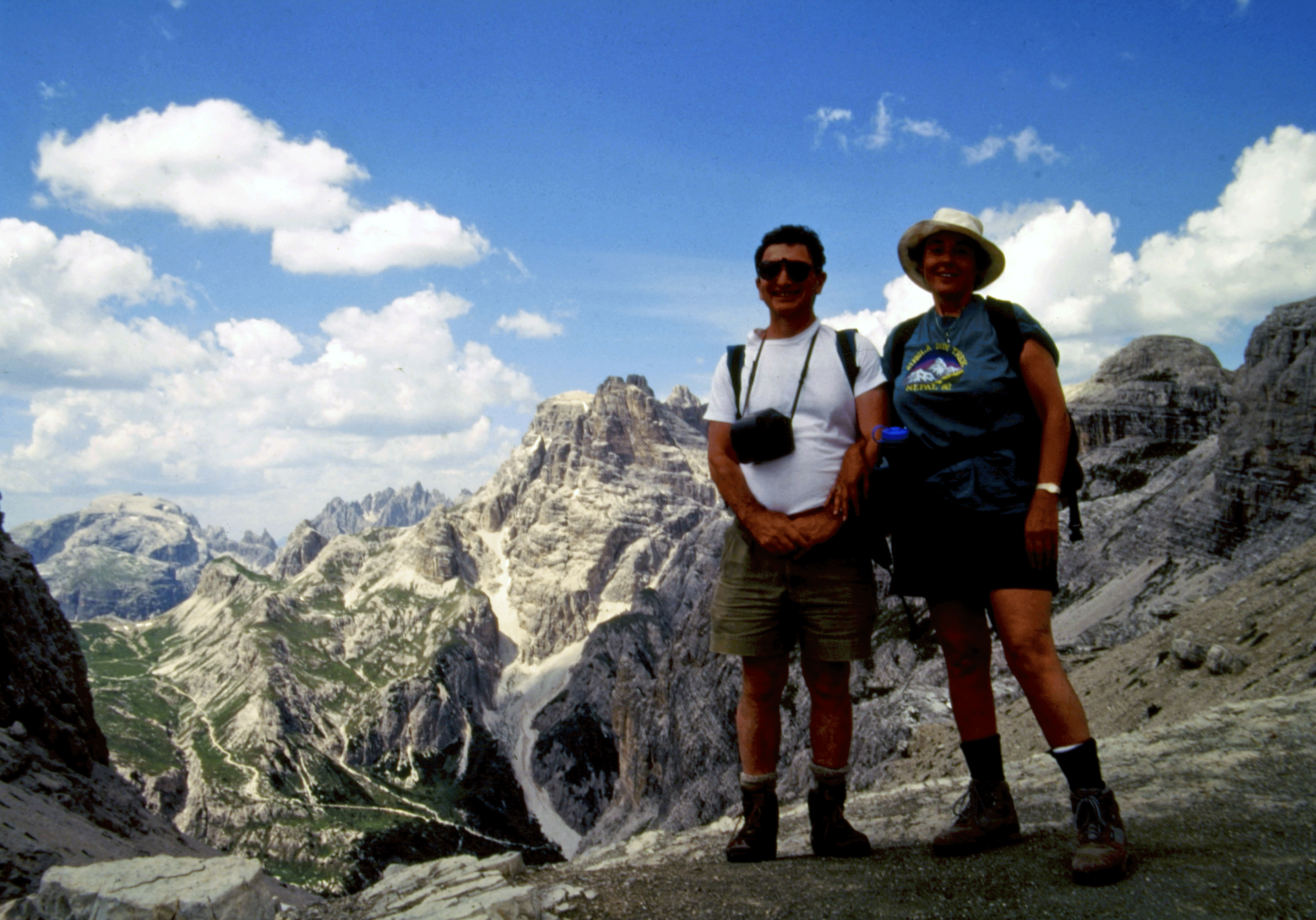Chapter 1
We fly to Milan (via London, because it’s cheaper). No problems.
Chapter 2
We take a bus from the airport and disembark at the last stop. Our hotel is only a few blocks away, but it takes an hour--laden with luggage and speaking very primitive Italian--to find it.
Chapter 3
The next day we rent a Volkswagen (“Polo”) and manage to find our way out of the city. The autostrade to Verona is expensive but comfortable. Stay out of the left-most lane, unless you want to go 120 m.p.h.
Verona is lovely, as promised, though very hot. The mountains are to the north, enveloped in haze. We stroll about, avoiding Juliet’s tomb, and in a courtyard find a restaurant and free chamber music concert,.
Next morning, a 2.5 hour drive north to Bolzano. No reason to tarry, with the Dolomites beckoning, so we head east. The roads have hairpin turns, tunnels and steep grades, but are in good condition. Nor are there many other vehicles, as “the season” has not begun. Rocky peaks jut improbably from the bright green hillsides.
Next two nights in Canazei: a small town that, like many others we will see, consists almost entirely of inns and restaurants. We begin our hiking with a brief uphill to “Lupo Bianco,” which turns out to be a hotel to which we could have driven. The following afternoon we try something more ambitious from the nearby Sella Pass. Susan punks out quickly, believing she will fall off the mountain. She sits on a rock and waits for Steve, who retreats after the trail becomes a “via ferrata” equipped with steel cables.
Chapter 4
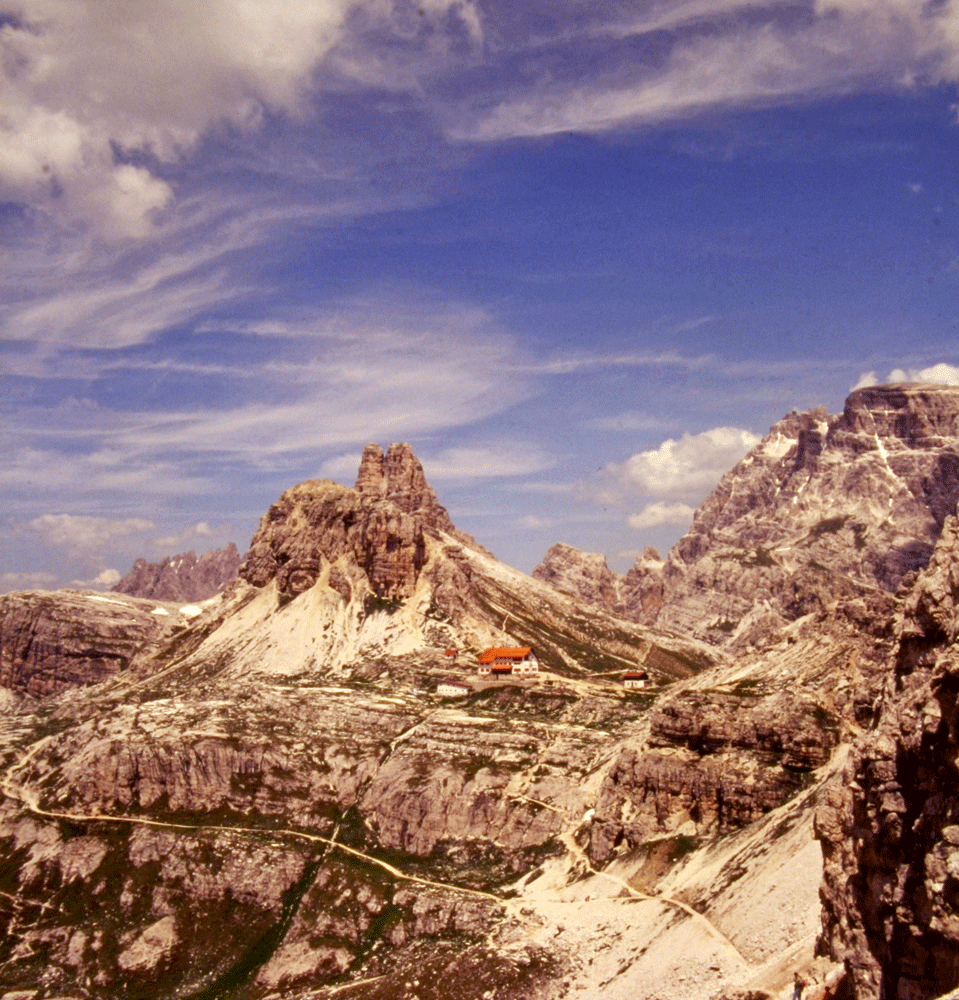
We spend our first night at a “rifugio”: a big building more like a hotel than a mountain hut. Some of these are accessible by road or cable car, others only by trail. All serve food and drink, the latter especially welcome in the heat. This one, the Coronelle, takes us two steep hours’ hike after lunch. We have a room to ourselves, with bunk beds and linen, though no private bath. Many day visitors, but few overnight. The staff are transf ixed by Italy’s televised World Cup match with Ireland.
Next day Steve embarks on a longish circuit of the mountains in back of the rifugio. Much up and down; spectacular views on all directions. He meets an East German couple who are able to travel at last, thanks to the demise of their Communist government. That night we return to civilization and yet another inn, the Hotel Rosa in Vigo di Fasso.
Chapter 5
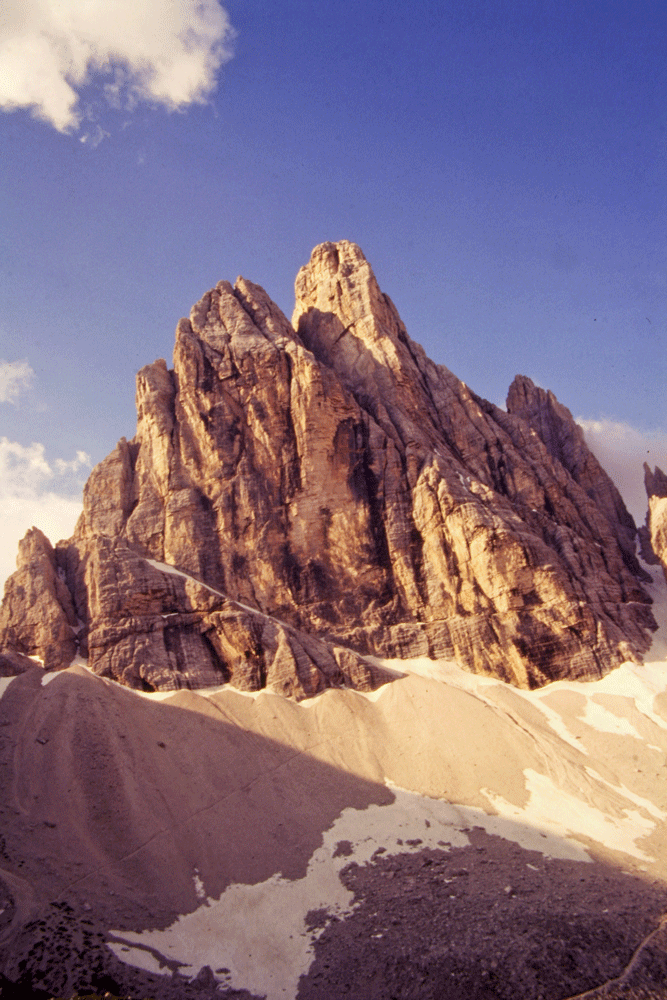
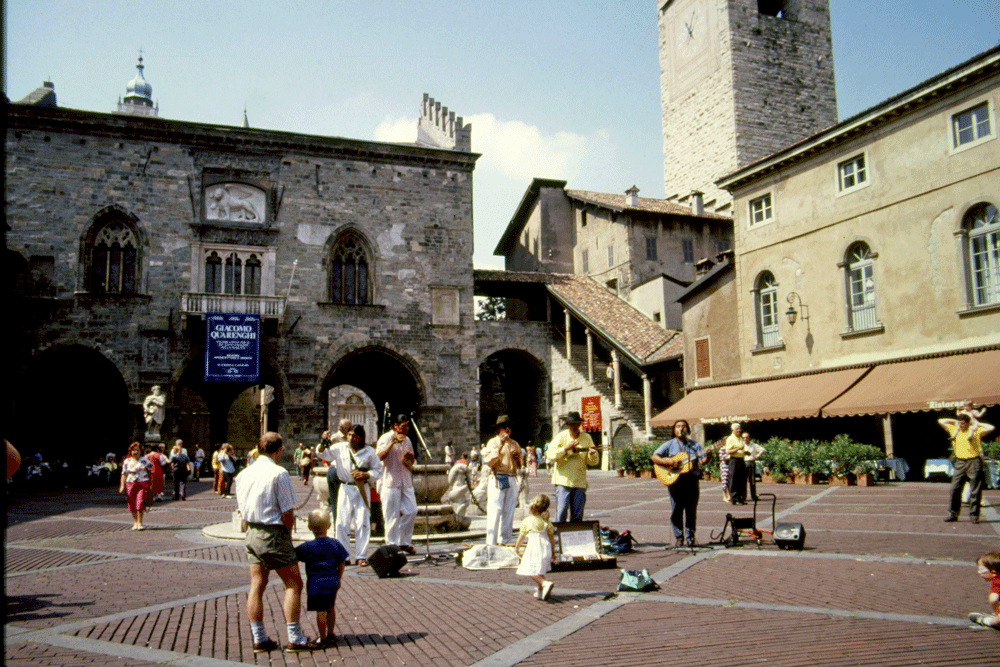
Weather remains warm, with occasional rain. After breakfast--the inevitable rolls with packets of butter and jelly--we continue east. A steep but shorter than expected takes us through Heidi-like fields and alpine flowers to the Rifugio Faleri, much smaller and homier than the Coronelle. The dining room walls are hung with pictures of climbers and routes, with one of the daughter of the house, aged perhaps 6, bedecked in climbing gear. There is also a photo of a giant Ital;ian basketball player. The climbing motif is appropriate, as the rifugio lies in the immense shadow of the south face of the Marmolada, one of the best climbing walls in the entire range. We attempt a modest hike but after an hour are turned back by cold, hostile rain. We recuperate at the rifugio with $2.50 cups of hot chocolate. Chapter 6
Two routes lead down from the hut: Susan favors the one we took up, which Steve calls unadventurous. We take his way, through a waterfall and snow. Susan reluctantly concedes that it was worth it.
Back down to the world of motor vehicles and on toward to Cortina d’Ampezzo, by far the largest of the many resort towns--a beautiful ride with great views of the Marmolada. We happen upon a pleasant hotel, the Montana, and stroll about. Among our stops is an office where Steve engages a climbing guide for the next morning--see appendix.
Chapter 7
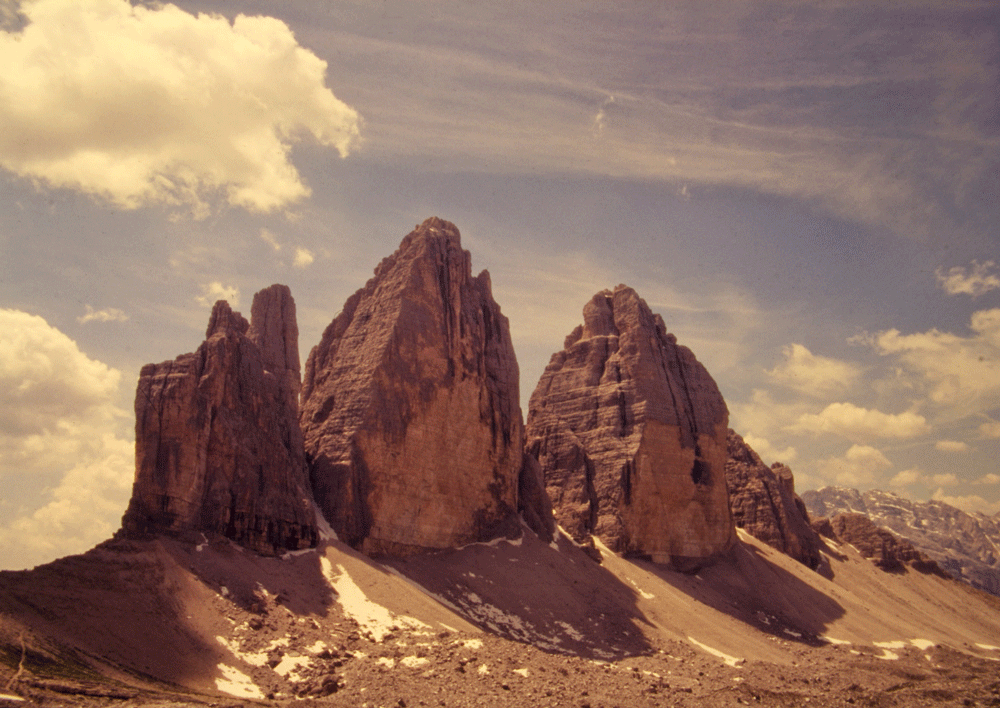
On to our last stop in the Dolomites, the great yellow-orange bulk of the Tre Cime di Laveredo. Even this early in the summer, the area is overrun with hikers. Some 60 school kids dot the trails, along with hundreds of tourists. They are mainly German and Italian. Almost no Americans. An exception is a man who attended Susan’s high school (Forest Hills, Queens) and has an academic friend in common with Steve.
The north walls of the Cime Grande and the Cima Ovest are amazingly sheer. No climbers can be seen. We spend an arduous four hours trekking to the Rifugio Locatelli, which swarms with hikers, and to another rifugio named for two famous rock climbers, Zsigmondy and Comici, where we can gaze at the stupendous peak, Croda di Brosci. By this time we have begun counting our lira, which evaporate fast in hot weather. It’s Saturday and the banks are closed and there aren’t any banks up here anyway. The rifugios don’t take credit cards. We share a soup and pasta for dinner. The next day we splurge on a birra grande for lunch, which leaves us with about $3.00. Then Steve miraculously (or infuriatingly, as you choose) discovers another ten thousand lira, enough for a Coke and an apple strudel, plus some chocolate. Survival is thus assured. That evening our credit cards gain us a room at a four-star hotel that claims Liz Taylor and Richard Burton as previous guests.
Chapter 8
We head for the Rifugio Lagazuoi, near Steve’s guided climb of a few days before. It’s strictly uphill; we are startled to see a bunch of mountain bikers striding up with their machines. Will they really bike down these steep slopes? The rifugio has a huge deck, giving a view of storm clouds gathering over the Marmolada to the west. A European-American film crew is hard at work. We hope it is to be a Major Motion Picture in need of extras, but it is only a milk commercial. The star, Miss Purity, shivers in a scanty costume and sips a soft drink as she awaits the next take.
For the only time, we take the easy way down--cable car. A few airy minutes back to the road.
Chapter 9
The roads remain spectacular as we drive south out of the mountains. We spend the night in the small city of Belluno. During dinner the place seems virtually deserted. The waiter keeps dashing into the kitchen, whence come intermittent shouts. The moment we return to the hotel, the town explodes in euphoria: Italy has beaten Nigeria in the latest round of the World Cup. For hours celebrants jam the piazza, in car and on foot, the national flag flying. Only a downpour quiets them and permits us some sleep.
Chapter 10
We arrive at the north end of Italy’s biggest lake, Garda. It’s another world: hot, the high season underway, thousands of tourists. Here we spend three nights. One day it rains, emphatically. The other we take a boat trip of Gabriele d’Annuzio’s gaudy villa, Vittoriale. Susan swims in the frigid lake; Steve tries to, and has back spasms.
Chapter 11
We return the car in Brescia and haul ourselves and gear on the train for Bergamo. It’s Saturday again, and for the first time rooms are scarce. We end up, at considerable but not outlandish expense, in a duplex with terrace, two bedrooms, living room, kitchen and bath. The town is lovely. Italy wins another World Cup match.
Then: back to Milan, London, and Newark airport.
Statistics:
Miles driven: 610. Hotels and rifugios stayed at: 13.
Items lost:
by Steve (5)
--cap
--pocket knife
--international driver’s license (recovered)
--Visa card (recovered)
--car rental voucher
by Susan (0)
Languages used (in descending order of competence)
English
gestures
French
Italian
German
Books read: by Susan (7); by Steve (3)
Appendix for climbers:
The Dolomites have routes of all difficulties and lengths, up to 1500 feet or so. I hired a guide in Cortina and asked for something moderate. He responded with the Torre Piccola di Falzarego, a half hour’s drive from the town. On the way I learned that the guide, Georgio, despite his elderly appearance (he was three years my junior), had fairly recently been to 8000 meters on the North Ridge of K2, not to mention expeditions to the Annapurnas, Aconcacgua, and Denali. He regarded Denali as the coldest and most dangerous of all his climbs.
Although early in the season, it was a Saturday, and a number of folks were already on their way to the various routes on the Torre. “It is good for us to be ahead of them,” Georgio said, so we rushed up the hill exhaustingly. For the first few pitches we stayed even with a three-man Italian team. Their method was for the two followers to climb simultaneously, both belayed by the leader. The seemingly universal belaying practice involves a clove hitch around a carabiner clipped to a piton--no belay plate, no rope behind the back. “Piton” means either piton or cemented iron bar, which is also used for protection. The routes have red painted splotches, like trail markers.
The climb was six long pitches, some quite easy, some with passages of 5.5. The rock was solid--not always the case in the range. One very steep rappel took us to a descent gully.
It is easy to find good guides, but expensive--my short day cost about $200. Bring shoes and harness. If climbing on your own, take English-language guidebooks unless you read German or Italian. A helmet is needed.
